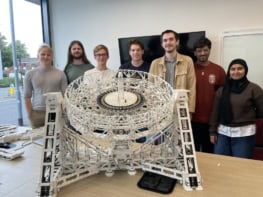
It’s a classic trope of science fiction: aliens watching the Earth from a distance.
But what would an alien really see if they were studying our planet? It’s an intriguing question, because if we knew what we look like as a tiny dot to someone a long distance away, then we could work backwards – examining our murky data on far-away exoplanets to find out what those distant worlds are actually like.
James Romero explores this fascinating new dimension to exoplanet hunting in the May issue of Physics World magazine, which is now out.
Remember that if you’re a member of the Institute of Physics, you can read the whole of Physics World magazine every month via our digital apps for iOS, Android and Web browsers. Let us know what you think about the issue on Twitter, Facebook or by e-mailing us at pwld@ioppublishing.org.
For the record, here’s a rundown of what else is in the issue.
• Biophysics emerges as a major field – The first “decadal” survey into biological physics says the subject should be recognized as a central discipline of physics, as Michael Banks reports
• China set for major upgrade – Scientists in China have begun a transformation of the Beijing Electron Positron Collider that could pave the way for a future Higgs factory. Ling Xin finds out
• A more accessible discipline – Claire Malone says creating a better working environment for those with physical disabilities can end up benefitting everyone
• Light fantastic – To celebrate the International Day of Light, James McKenzie reflects on the wonders of optical communications
• Avoiding artefacts – Can you distinguish experimental errors from the real voice of nature? Robert P Crease wants your stories

Time crystals, life as a tech founder and demons as teachers: the April 2022 issue of Physics World magazine is now out
• The Earth through alien eyes – Aliens spying on us from across interstellar space is a classic trope of science fiction. But working out what those extraterrestrials might see if they pointed their telescopes at us could help in our quest for finding life on distant Earth-like planets, as James Romero explains
• The legacy of Liverpool’s synchrocyclotron – The University of Liverpool’s synchrocyclotron helped define physics in the 20th century, yet little trace of it remains. Rob Lea looks into the history of this lost machine
• Concerning primordial black holes – Born at the dawn of time, primordial black holes may lurk throughout the universe – should they exist. But what if one struck the Earth or even, perhaps, a human being? Ian Randall discovers whether there is legitimate cause for concern or if such a scenario is mere science fiction
• A steampunk guide to quantum physics – Philip Ball reviews Quantum Steampunk: the Physics of Yesterday’s Tomorrow by Nicole Yunger Halpern
• Human versus machine in space – Andrew Robinson reviews The End of Astronauts: Why Robots Are the Future of Exploration by Donald Goldsmith and Martin Rees
• Opening up innovation and change – Roland Harwood is a physicist who is fascinated by the art of open innovation. He tells Rachel Brazil how he has helped organizations ranging from Lego to the UN to implement change and why he believes that physics is leading the way when it comes to collaboration
• Web of confusion – Jon Tarrant bemoans why so much online physics information is just so plain wrong.



